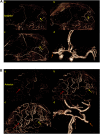Assessment of leptomeningeal collaterals using dynamic CT angiography in patients with acute ischemic stroke
- PMID: 23149554
- PMCID: PMC3587807
- DOI: 10.1038/jcbfm.2012.171
Assessment of leptomeningeal collaterals using dynamic CT angiography in patients with acute ischemic stroke
Abstract
Whole-brain dynamic time-resolved computed tomography angiography (CTA) is a technique developed on the new 320-detector row CT scanner capable of generating time-resolved cerebral angiograms from skull base to vertex. Unlike a conventional cerebral angiogram, this technique visualizes pial arterial filling in all vascular territories, thereby providing additional hemodynamic information. Ours was a retrospective study of consecutive patients with ischemic stroke and M1 middle cerebral artery +/- intracranial internal carotid artery occlusions presenting to our center from June 2010 and undergoing dynamic time-resolved CTA and perfusion CT within 6 hours of symptom onset. Leptomeningeal collateral status was assessed by determining relative prominence of pial arteries in the ischemic region, rate and extent of retrograde flow, and various topographical patterns of pial arterial filling. Twenty-five patients were included in the study. We demonstrate the existence of the following novel properties of leptomeningeal collaterals in humans: (a) posterior (posterior cerebral artery (PCA)-MCA) dominant collateralization, (b) intra-territorial 'within MCA region' leptomeningeal collaterals, and (c) significant variability in size, extent, and retrograde filling time in pial arteries. We also describe a simple and reliable collateral grading template that, for the first time on dynamic CTA, incorporates back-filling time as well as size and extent of collateral filling.
Figures




References
-
- Liebeskind DS. Collateral circulation. Stroke. 2003;34:2279–2284. - PubMed
Publication types
MeSH terms
LinkOut - more resources
Full Text Sources
Other Literature Sources
Medical

